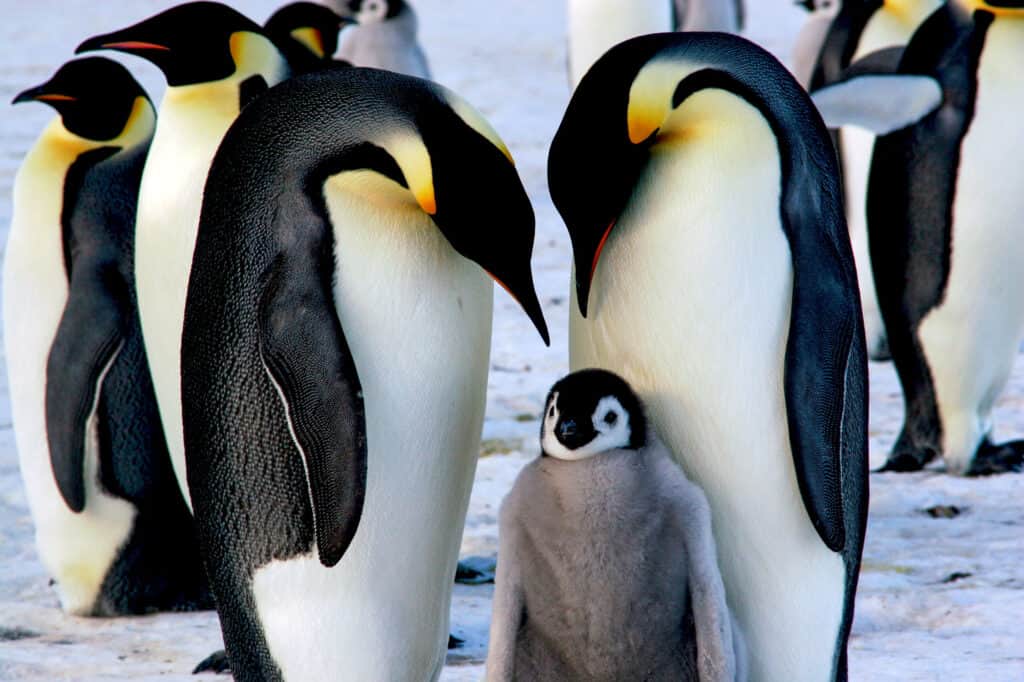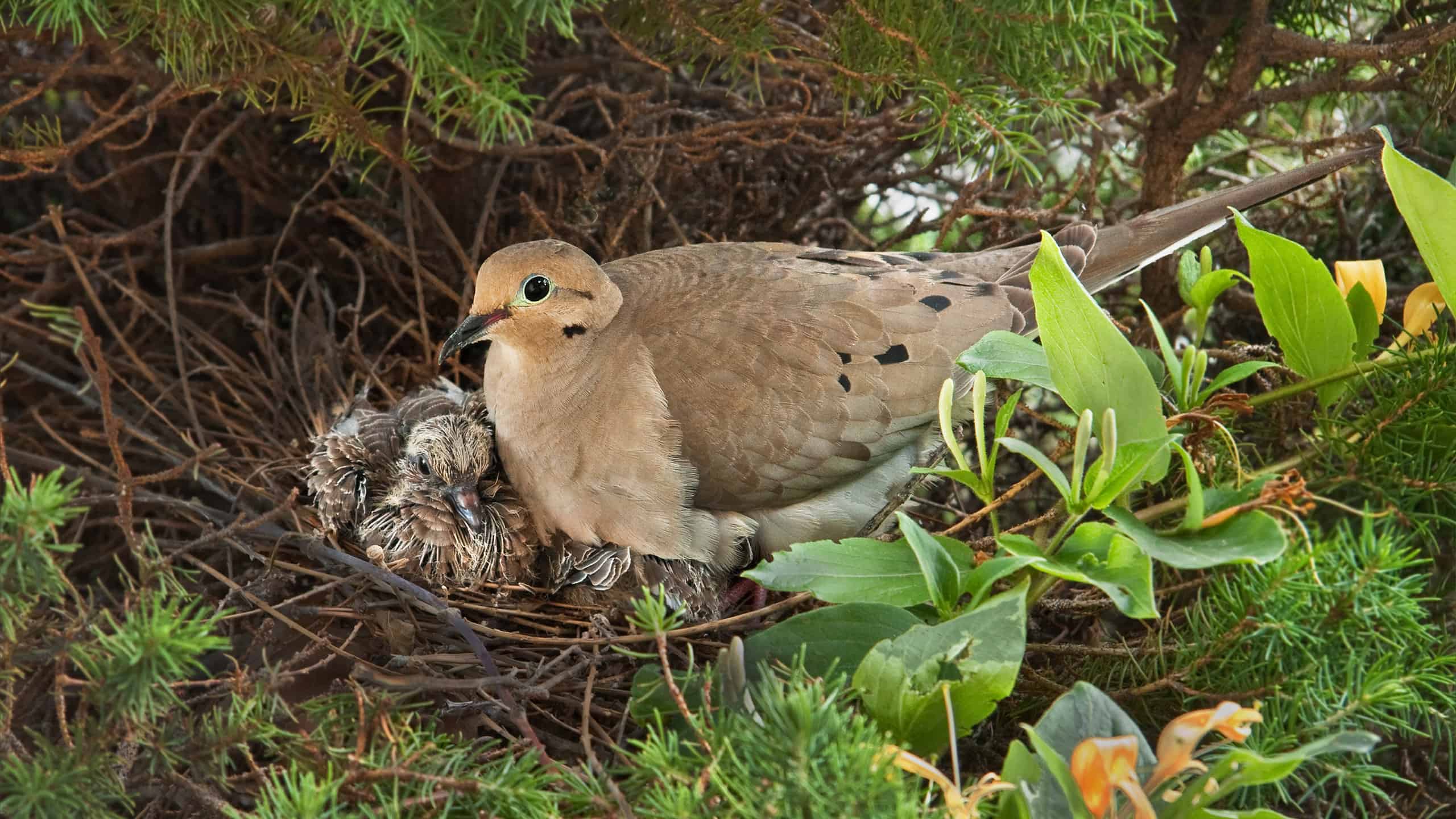As you stumble upon a bird’s nest in your yard, your curiosity kicks in. You can’t help but wonder: How long will it take for those little eggs to hatch? And once they do, how long do those adorable baby birds stay in the nest?
This article delves into the fascinating lives of baby birds. We’ll uncover the reasons behind songbirds’ preference for lingering in their cozy nests longer than other species. And speaking of nests, have you ever wondered who takes on the heavy lifting when it comes to nest building? Well, we’ve got that covered too. Follow along to learn all about these incredible creatures and the world they call home.
How Long Birds Stay in the Nest

Altricial birds, like songbirds’, are born helpless and stay in the nest longer.
©Genc Subhan/Shutterstock.com
Songbirds usually stay in the nest for 2 to 3 weeks. Most owls stay in the nest for 6 weeks. Raptors leave the nest around 8 to 10 weeks, and bald eagles usually stay for 10 weeks.
Songbirds, like pigeons, woodpeckers, and hummingbirds, are born helpless. It takes them a bit longer to develop their thinking skills compared to other birds. That’s why they’re called altricial birds. They rely heavily on their parents for support and care during those early weeks.
On the other hand, we have precocial birds like ducks, geese, swans, and turkeys. These hatchings are born relatively mature and mobile. It’s not uncommon for precocial birds to be out and about shortly after hatching, searching for food alongside their parents shortly after they hatch. It’s impressive how much faster precocial birds develop in comparison to altricial songbirds. But being mature doesn’t mean they’re ready to live life alone. Precocial birds still need their parents.
Chickens are an example of precocial birds that can walk and explore shortly after hatching but still rely on parental protection. Geese are another good example. Goslings can walk, swim, and feed from 1-2 days old. But they can’t fly until 2-3 months old, so they stay with their parents for the first year.
Baby Penguins Stay with Parents for Months

Emperor penguin babies stay with their parents for 5 months.
©iStock.com/BernardBreton
There are also bird species, like certain penguins and gulls, that are a bit of both, making them semi-altricial or semi-precocial. The great emperor penguin is a “semi-altricial” bird. They don’t quite qualify as precocial like a chicken or altricial like a songbird.
Baby penguins have feathers like precocial birds, but they’re unable to learn hunting skills in the first few weeks of life. Their natal down is not waterproof, so they can’t go underwater. Since penguins hunt in the ocean, the young birds depend on their parents for food until they’re old enough to molt and replace their down feathers with adult feathers. Young will stay in the care of their parents until about 5 months of age. Emperor and king penguins don’t build nests like other birds.
Birds with down feathers, like ducks and pheasants, may leave the nest shortly after hatching.
Larger birds, such as owls, hawks, and eagles, have longer nest stays, with California condors leaving when they’re 6 months old.
Nest Life

Baby birds grow a lot during their first week of life, sometimes doubling their body weight multiple times.
©iStock.com/PJ66431470
What’s life like for a baby bird living in a nest? Most songbirds are ready to leave the nest after 2 or 3 weeks. During these precious weeks, a lot of growth happens. By the end of that first week, baby birds show big changes. Their eyes pop open, and you start to see their feathers emerging. During this first week, they can double their body weight multiple times, which is quite the growth spurt.
A baby bird’s life centers around food, finding it, and not becoming it. Parents continuously forage for food to meet the demands of nestlings. The cries of nestlings can attract unwanted attention from predators. It’s a dangerous time for babies and parents.
Knowing When to Leave the Nest

For the best chances of survival, baby birds have to leave the nest before they start attracting predators.
©Sainam51/Shutterstock.com
Leaving the nest has to be timed just right. Younger birds are at higher risk in the wild, while older birds can attract predators and crowd the nest. Species that nest near the ground tend to push their young to leave early. Otherwise, they could become a meal for a hungry predator.
After leaving the nest, young birds remain close to their parents for a short period, learning to survive independently. After surviving their first year, their chances of surviving another year go way up. The first year is the toughest for young birds, who are likely to make mistakes. For instance, it’s usually juvenile eagles who try to snatch up prey that’s too large for their talons.
What Goes into Nest Building?

Eagle nests can easily weigh 2,000 pounds.
©iStock.com/PaulReevesPhotography
Birds don’t exclusively nest in summer; breeding can happen throughout the year, even in the southern parts of the United States. And while most birds nest only once yearly, some species, like the American Robin, can have multiple nests in a breeding season.
Building nests is an essential activity for birds, providing a secure environment for their eggs and young ones to grow. Bird nests exhibit a wide range of diversity, each species having its own distinctive nest style.
Hummingbirds are known for building the smallest nests. The vervain hummingbird’s nest is half the size of a ping-pong ball. On the other side of the scale, the largest recorded bald eagle nest weighed over 4,000 pounds.
While some birds choose a simple hollow on the ground to lay their eggs, others build nests using materials such as grass, leaves, fur, or even paper. Interestingly, it’s usually the females who do the construction work. Take red-winged blackbirds, for example. They establish territories but leave the nest-building task to the females. However, there are instances where both parents or only the males participate in this process. Sandhill cranes, on the other hand, work together to construct the nest and incubate the eggs. Male wrens have a unique strategy—they construct multiple nests, giving females the opportunity to choose a mate based on their nest-building skills.
No Nest Needed: Birds That Don’t Build Nests

The common tern creates an untraditional nest, using sand, gravel, and nearby plants to protect chicks.
©ViktoriaIvanets/Shutterstock.com
Some birds don’t bother with the hassle of nest-building. Take the chuck-will’s-widow, for example. This clever bird lays its eggs on the ground, among leaves and dirt. You might think it’s a lazy approach, but there’s a method to their “bare-egg” strategy. The eggs are intricately patterned to blend perfectly with the surrounding leaf litter. The patterning provides excellent camouflage and reduces the risk of predation.
The common white tern also foregoes constructing a traditional nest. They actually like to gather in big groups and make their ground nests. They usually pick spots near the water, with loose sand and gravel. They look for areas with low-growing plants around to give their little chicks some hiding spots. It’s possible this nestless behavior began as a response to nest parasites in seabird colonies. The black noddy, a close relative, builds nests in the canopy, but the white tern forgoes construction.
Common murres lay their eggs directly on cliff ledges and incubate them there. The pointed shape of their eggs helps prevent them from rolling off the cliff. Parents have to keep an extra watchful eye on their cliff eggs. The lack of a nest for protection means staying with the eggs constantly to fight off hungry gulls and crows.
And let’s not forget about the brown-headed cowbirds. These sneaky birds have a unique approach to parenting — they use someone else’s nest! They’re considered “brood parasites.” These birds steal nests from other unsuspecting bird parents all across the United States. Rather than taking care of their own offspring, they lay their eggs in the nests of other birds, leaving the unsuspecting hosts to raise their chicks.
Thank you for reading! Have some feedback for us? Contact the AZ Animals editorial team.








